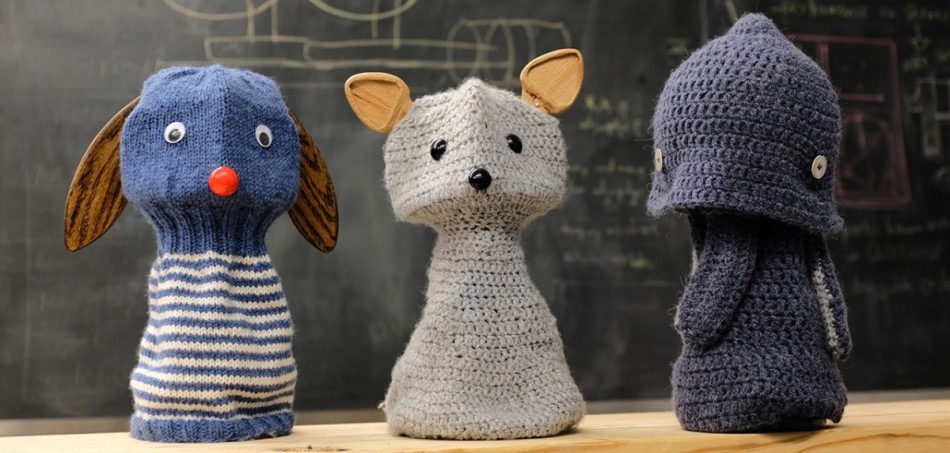May 22 2019
Social robots started to appear in homes and stores some years ago, and that’s when Guy Hoffman thought why they all resembled each other very much.
 Blossom robots can be constructed by users from handcrafted materials, making each one a little bit different. (Image credit: Michael Suguitan)
Blossom robots can be constructed by users from handcrafted materials, making each one a little bit different. (Image credit: Michael Suguitan)
“I noticed a lot of them had a very similar kind of feature—white and plasticky, designed like consumer electronic devices. Especially when these social robots were marketed to be part of our families, I thought it would be strange to all have identical family members.”
Hoffman, Assistant Professor and the Mills Family Faculty Fellow, Sibley School of Mechanical and Aerospace Engineering
He imagined robots made from warmer, homier materials, such as wool and wood; he also envisioned robots that could be modified by their owners, so that each would be unique. One of his friends offered him knitted models of his robots and he imagined: What if the robot itself was knitted? So he learned to knit.
Later, he saw another friend knitting part of the robot much quicker than he could. “That made me think people who are not engineers could also participate in making a robot,” he stated.
These thoughts made Hoffman develop Blossom, which is a simple, expressive, cheap robot platform that could be created from a kit and innovatively equipped with handcrafted materials.
“We wanted to empower people to build their own robot, but without sacrificing how expressive it is,” said Hoffman, senior author of “Blossom: A Handcrafted Open-Source Robot,” reported in March in the Association for Computing Machinery Transactions on Human-Robot Interaction. “Also, it’s nice to have every robot be a little bit different. If you knit your robot, every family would have their own robot that would be unique to them.”
Blossom’s mechanical design—created with Michael Suguitan, a doctoral student in Hoffman’s lab and first author of the paper—is focused on a floating “head” platform using strings and cables for movement, making its actions more flexible and organic when compared to those of a robot made up of stiff parts.
Blossom can be maneuvered by moving a smartphone with the help of an open-source puppeteering app; the robot’s movements include stretching, dancing, and bouncing. The cost of the parts required to assemble a Blossom is below $250, and scientists are now working on a Blossom kit composed completely of cardboard, which would be much cheaper.
Hoffman stated that Blossom has a range of potential uses partly due to its ease. Human-robot interaction investigators who are not engineers could make their own robot from a kit to use in research works. Due to the effortlessness of interacting with the robot and the hands-on experience of helping to make it, it could help train children about robotics.
In a case study, children aged between 4 and 8 got an opportunity to control and build accessories for Blossom at a science fair. Some children developed accessories, like jewelry or appendages, while others controlled the robot so that the new items could be fixed to it, demonstrating how Blossom could encourage collaboration.
“The children also had additional expectation of the robot’s movement, such as making it locomote and jump. These expectations were emphasized by that fact that several children chose to make appendages such as legs and wings,” the authors wrote.
Hoffman stated that in the following months, Blossom will be employed by the Upper Grand school district in Ontario, Canada, to help teach math to fourth-graders.
He reported that his team has also been working on an algorithm to make Blossom respond to YouTube videos—for example, performing a particular dance in response to a specific song—taking advantage of the prior research demonstrating that a robot’s response to listening to songs can have an impact on a human’s reaction. Hoffman stated that this might be mainly helpful in modeling behavior for autistic children.
It’s meant to be a flexible kit that is also very low cost. Especially if we can make it out of cardboard, you could make it very inexpensively. Because of computation becoming so powerful, it could be a really open-ended way for people to do whatever they want with robotics.
Hoffman, Assistant Professor and the Mills Family Faculty Fellow, Sibley School of Mechanical and Aerospace Engineering
The research was supported in part by a grant from Google Creative Robotics.
Blossom - A Handcrafted Social Robot - Soft Inside and Out
Blossom is a collaboration between Cornell University’s Human-Robot Collaboration and Companionship Lab and Google Creative Technologies Singapore. (Video credit: Cornell University)